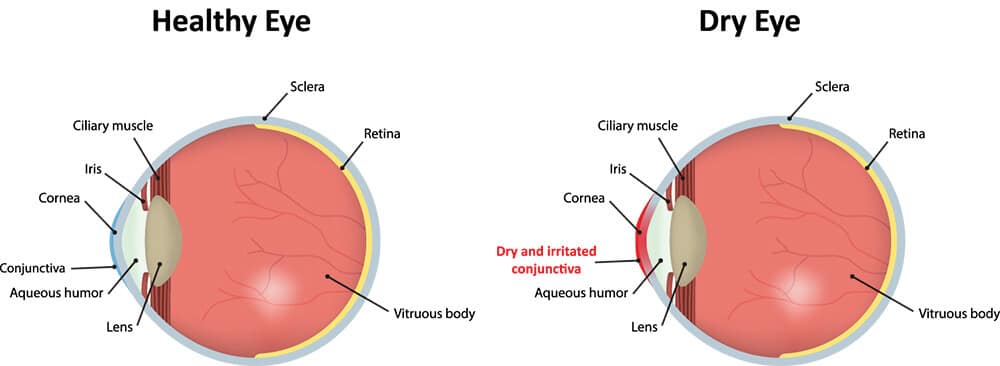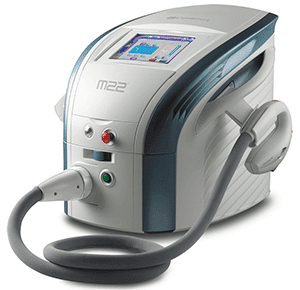Dry Eye
Home » Dry Eye
Eye Watering and Excessive Tearing: Dry Eye
Oddly enough, if you are prone to excessive eye watering or tearing, you might actually have a condition called dry eye. Dry eye occurs when the eyes do not produce sufficient tears or the tears evaporate too quickly. For many people reflex tearing, or tears running down the face, is the body’s attempt to heal a dry eye.
There are two types of dry eye:
Evaporative Dry Eye
Accounting for more than 80% of all dry eye: caused by blockage to the eyelid glands (meibomian glands) which leads to a shortage of oil on the surface of the tears and quicker-than-normal tear evaporation.
Aqueous Dry Eye
Accounting for less than 20% of all dry eye: occurs when the lacrimal glands do not produce enough tears.
Symptoms of Dry Eye
Tears are necessary to help lubricate, protect and nourish our eyes. Without a steady flow of tears, eye irritation will result.
- Watering/tearing
- Itching
- Stinging
- Redness
- Light sensitivity
- Eye fatigue
- Blurry vision
Without proper treatment, inadequate tears can make daily activities frustrating, affecting your personal and professional life; activities like reading, watching TV, driving or working on the computer.
Treatment for Dry Eye
For some patients, over-the-counter eye drops will provide relief for dry eye symptoms. However, if these are ineffective you may need to have an eye doctor assess your situation and determine the root cause of your dry eye. Knowing the reason for your dry eye symptoms is the only way to successfully treat this condition. Our dry eye specialists may recommend:
- Artifical Tears
- RESTASIS®, Xiidra® and Cequa™ eye drops to increase tear production and treat inflammation
- Punctal plugs to prevent tear drainage from the eyes
- Intense Pulsed Light (IPL) therapy to unblock clogged eye glands
- Lid scrubs/warm compress
- Nutritional supplements such as Vitamin A, Vitamin D and Omega-3 fatty acids
- Antibiotics such as Doxycycline to reduce inflammation
Eye Drops
When your eyes are unable to produce sufficient tears, you have a condition called Aqueous Dry Eye. This can become a chronic condition which causes great discomfort due to lack of lubrication and protection, making daily activities difficult. We offer a variety of eye drops (RESTASIS® Ophthalmic Emulsion, Xiidra® and Cequa™) to treat the ongoing symptoms of Chronic Dry Eye. These prescription eye drops help increase your eye’s natural ability to produce tears or treat inflammation of your eye surface.
Punctal Plugs
A punctal plug is a tiny rubber stopper inserted into the tear duct to slow the drainage – acting similar to a stopper in a bathtub or sink. Sometimes it is necessary to close the ducts that drain tears out of the eyes in order to treat symptoms of dry eye. These tiny plugs can be inserted in an exam room with topical antiseptic to achieve better lubrication of the eyes by slowing the drainage of tears.
Temporary Punctal Occlusion
Temporary plugs can be inserted into the tear drain of the lower eyelid to determine if this helps provide adequate tears. These plugs can be removable or dissolvable within a few days to a few months.
Permanent Punctal Occlusion
If the temporary plugs work well, our doctors may suggest permanent (yet removable) plugs. The goal is to provide adequate tears/lubrication, improve patient comfort and reduce the need for artificial tears. In rare cases the plugs may come out spontaneously or migrate down the tear drain.
Our doctors will measure your tear duct size to determine the right size and type of punctal plug to achieve the best results.
Intense Pulsed Light (IPL)
Often, the root cause of dry eye is meibomian gland dysfunction, the medical term for a blockage or other abnormality that prevents these specialized glands from properly functioning. When these glands are unable to provide enough oils onto the surface of your eyes, you may experience discomfort, inflammation and bacterial infection.
An effective treatment method may be Intense Pulsed Light (IPL) therapy. Originally used to treat rosacea, IPL decreases inflammation and opens the eye glands. The process involves the application of warm light pulses near the eyelid glands. The light is absorbed by the blood vessels, heat is generated and the glands open to allow fluids to flow freely.
During each 10-minute treatment, a gel is applied to your eyes and protective pads or goggles are placed over your eyes. The IPL treatment is gentle and comfortable for most patients. For maximum effects, you may require 2-4 treatments at least 2 weeks apart as well as annual treatments to maintain your results.
It is normal to experience temporary redness around the eyes for a few hours after treatment. We recommend that you avoid direct sunlight for a few days after your treatment. Not everyone is a good candidate for IPL treatment. Our doctors can assess your condition and let you know if this might be an effective treatment for you.
If you are suffering from dry eye in Harrisburg, contact us today to schedule an eye exam and find out if our treatments might provide relief.



